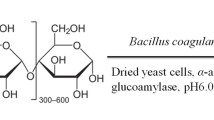Abstract
After crude protein of the marine yeast strains maintained in this laboratory was estimated by the method of Kjehldahl, we found that the G7a strain which was identified to be a strain of Cryptococcus aureus according to the routine identification and molecular methods contained high level of protein and could grow on a wide range of carbon sources. The optimal medium for single-cell protein production was seawater containing 6.0 g of wet weight of Jerusalem artichoke extract per 100 ml of medium and 4.0 g of the hydrolysate of soybean meal per 100 ml of medium, while the optimal conditions for single-cell protein production were pH 5.0 and 28.0°C. After fermentation for 56 h, 10.1 g of cell dry weight per liter of medium and 53.0 g of crude protein per 100 g of cell dry weight (5.4 g/l of medium) were achieved, leaving 0.05 g of reducing sugar per 100 ml of medium and 0.072 g of total sugar per 100 ml of medium total sugar in the fermented medium. The yeast strain only contained 2.1 g of nucleic acid per 100 g of cell dry weight, but its cells contained a large amount of C16:0 (19.0%), C18:0 (46.3%), and C18:1 (33.3%) fatty acids and had a large amount of essential amino acids, especially lysine (12.6%) and leucine (9.1%), and vitamin C (2.2 mg per 100 g of cell dry weight). These results show that the new marine yeast strain was suitable for single-cell protein production.






Similar content being viewed by others
References
Brown MR, Barrett SM, Volkman JK, Nearhos SP, Nell JA (1996) Biochemical composition of new yeasts and bacteria evaluated as food for bivalve aquaculture. Aquaculture 143:341–360
Chi ZM, Zhao SZ (2003) Optimization of medium and cultivation conditions for pullulan production by a new pullulan-producing yeast strain. Enzyme Microb Technol 33:206–211
Chi Z, Liu J, Zhang W (2001) Trehalose accumulation from soluble starch by Saccharomycopsis fibuligera sdu. Enzyme Microb Technol 28:240–245
Chi Z, Liu Z, Gao L, Gong F, Ma C, Wang XH, Li HF (2006) Marine yeasts and their applications in mariculture. Journal of Ocean University of China 5:251–256
Feng DX, Zhao BG (1997) Evaluation of protein quality of the new feeds by using essential amino acid index (EAAI). China Feed 7:10–13
Hancock RD, Galpin JR, Viola R (2000) Biosynthesis of l-ascorbic acid (vitamin C) by Saccharomyces cerevisiae. FEMS Microbiol Lett 186:245–250
Kochert G (1978) Quantitation of the macromolecular components of microalgae. In: Hellebust JA, Craigie JS (eds) Handbook of physiological methods: physiological and biochemical methods. Cambridge University Press, Cambridge, pp 190–195
Kaur N, Gupta A (2002) Applications of inulin and oligofructose in health and nutrition. J Biosci 27:703–714
Patil RS, Ghormade V, Deshpande MV (2000) Chitinolytic enzymes: an exploration. Enzyme Microb Technol 26:473–483
Ravindra AP (2000) Value-added food: single cell protein. Biotechnol Adv 18:459–479
Rhishipal R, Philip R (1998) Selection of marine yeasts for the generation of single cell protein from prawn-shell. Bioresour Technol 65:255–266
Sheng J, Chi ZM, Li J, Gao LM, Gong F (2007) Inulinase production by the marine yeast Cryptococcus aureus G7a and inulin hydrolysis by the crude inulinase. Proc Biochem 42:805–811
Spiro RG (1966) Analysis of sugars found in glycoproteins. Methods Enzymol 8:3–26
Stottrup JG, McEvoy LA (2003) Live feeds in marine aquaculture. Blackwell Science Ltd, UK, pp 322–333
Strickland JDH, Parsons TR (1972) Kjehldahl method with ninhydrin finish (low levels). In: Stevenson JC (ed) A practical handbook of seawater analysis. Bull: Fisheries Research Board of Canada, Bull, pp 227–236
Acknowledgment
This research was supported by grants 2006AA09Z403 from Hi-Tech Research and Development Program of China (863) and LvKaRenCaiGongCheng program from Ocean University of China.
Author information
Authors and Affiliations
Corresponding author
Rights and permissions
About this article
Cite this article
Gao, L., Chi, Z., Sheng, J. et al. Single-cell protein production from Jerusalem artichoke extract by a recently isolated marine yeast Cryptococcus aureus G7a and its nutritive analysis. Appl Microbiol Biotechnol 77, 825–832 (2007). https://doi.org/10.1007/s00253-007-1210-7
Received:
Accepted:
Published:
Issue Date:
DOI: https://doi.org/10.1007/s00253-007-1210-7




